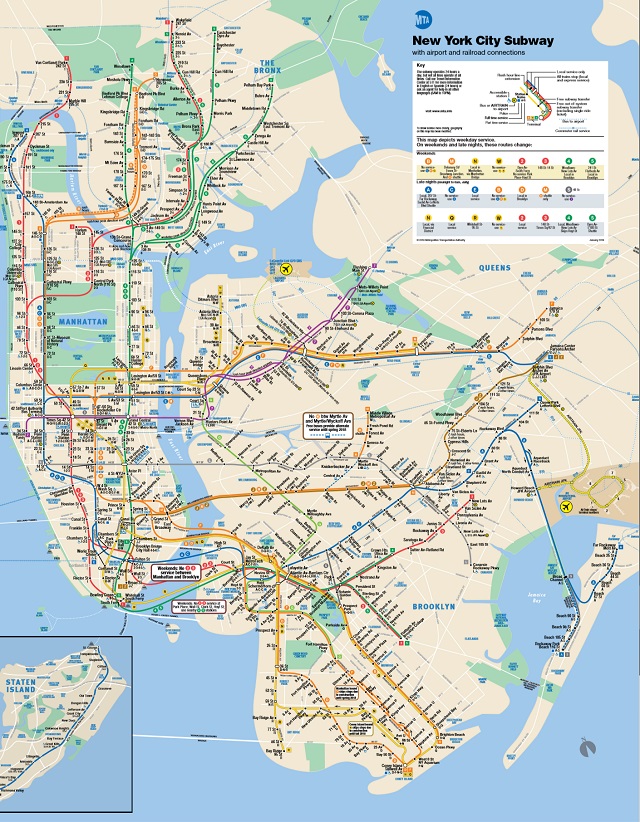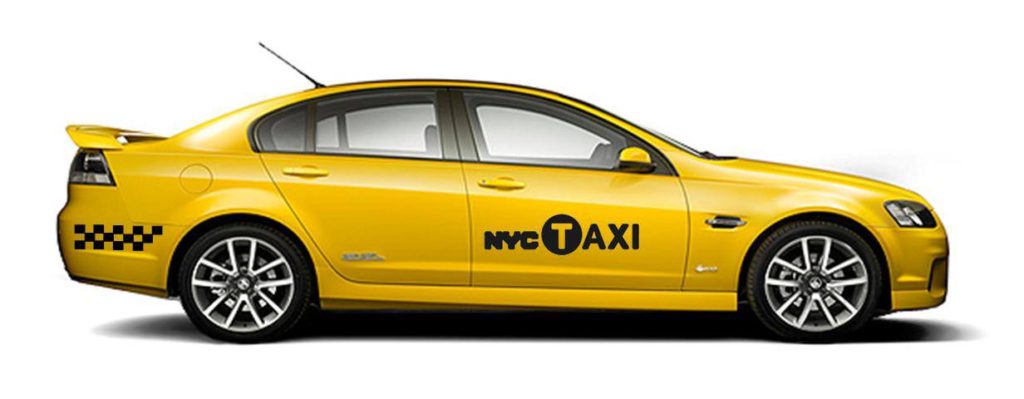Why Did the Koala Cross the Road? Chapter 8

Why did the Koala cross the Road?
Transportation around a US city can take many forms. This chapter will look at some of the different options of public and private transportation, as well as helpful tips on safely arriving at your destination.
A: The Koala’s car was parked on the other side.
For most Australians living outside of New York City, purchasing or leasing a vehicle is going to be their first choice in transportation. If you go this route, you are going to need motor vehicle insurance. As most insurance companies mandate that you first need to have a State drivers license, you are going to have to study and pass your State’s drivers license exams.

It varies from State to State, but in New York, after 90 days of maintaining a New York address, you have 30 days to get a NYS drivers license.
If after 120 days, you are still driving on your Australian license, you are technically driving without a license. This can lead to serious legal issues when pulled over by the Police, or involved in a simple fender bender.
It may seem like an inconvenience to visit your local DMV, apply for a learners permit, re-study the rules of the road and pass your State’s driving test. However, a State drivers license can also be used for ID on domestic flights, gaining entry into a Federal building, purchasing alcohol and is generally accepted as a better form of ID than an Australian drivers license from your bank to your employer. It is also easier to replace than a Passport if lost.
If you live in New York and want to test your knowledge, here is a link to the DMV Drivers Manual and Practice Test.
If you live in California, here is the link to the DMV Drivers Manual and Practice Test
Purchasing a car or truck in the US is a very different process than in Australia. Here are the links for New York and California for buying and selling a car.
For those who have never driven in the US, the simple mantra “Keep Right – Keep Right” whenever you make a turn, or even when driving in a straight line, will help keep you on the correct side of the road!
A: The Subway was on the other side.
The number one destination for Australians moving to the US is New York City. The number one form of transportation for those Australians is the Subway, so we are going to share some tips and tricks for navigating what can appear to be a complex system.

Navigating any Subway map is a simple process of understanding your starting point and your destination. New York can be a little more complicated in that some lines run express and others local. Sometimes you may use a combination of local and express trains to get to your destination in the most efficient manner.
The seasoned Subway rider can think four dimensionally and know which end of their destination station has the exit. They know where to stand on the platform so that when they arrive, they can exit the Subway in the shortest possible time.
The good news is that travel Apps will calculate the best routes by public transportation – which eliminates much of the guess work. In Manhattan, Subways typically run North/South and there are only a few that can get you East/West. Seasoned strap hangers will use a cross town bus to travel between East and West, and your Metrocard will give you a free transfer.
Purchasing a Metrocard is a very simple process at any subway station and you can use this link to see all of the places you can buy a Metrocard. You have the option for single rides, weekly or monthly Metrocards depending on how much you plan to use the Bus and Subway.
Here is the link to MTA website where you can see pricing and discount options, including a chart on the best value purchase options based on how much you use a bus or train.

To avoid your Metrocard running out of money, you can elect for EasyPay Express card. There are monthly and per ride options and you can click here for more information. If you purchase any Metrocard using a credit or debit card and you loose it, you can always get a pro-rated refund from the MTA.
The Subway undergoes regular maintenance, and sometimes this causes disruption to services, usually on the weekend. The MTA posts updates on these service interruptions on their website called The Weekender. You can click on each Subway line to check ahead if your weekend travel plans are going to be interrupted through maintenance.
A: The Koala’s Taxi was waiting on the other side.
To say NYC has thousands of Taxis is an understatement. The simplicity of waving down a taxi (with their roof ID number illuminated) in seconds is a convenient way to get around the city. However depending on the time of day, or the weather, it may be difficult to find one that is not already in use.
Always remember to tip!

Curb is an App that can book and pay for a Taxi in NYC and other cities across the US. There is a booking fee, but this may be offset by the convenience of not having to wait lengthy periods of time, or someone cutting in front of you and taking “your” cab!
You may already use UBER, but if you live in NYC there are other options for getting to your destination via a rideshare than can be quite cost effective.
They include: Lyft, Juno and Via. Via is also available in Chicago and DC.
There are also the NYC limo services, including Carmel and Dial 7 if you want to order a more up market vehicle ahead of time.
A: The Koala’s Rental Car was on the other side.
There are a surprising number of rental car companies in NYC, and they are usually based in parking garages. Those that are based in NYC typically have a higher daily rate than those in the Burroughs or on Long Island so if you are planning on renting a car for a long trip, it might be worth shopping around different locations for a better daily rate.
If you are looking to rent a car for just a few hours, ZipCar is available in major cities across the US. The Australian Community has negotiated a corporate rate for Aussies with a 20% discount on weekly rate as well as 50% off the joining fee! You can use this link to access our corporate rate.
A: The Train Station was on the other side.
All major cities have a transportation hub, and NYC has four: Penn Station, Grand Central Station, the Port Authority and the World Trade Center.
Penn Station is where you can access Long Island Rail Road (LIRR), Amtrak and New Jersey Transit trains. It is located between 8th and 9th Avenues on 34th Street. It is also accessible by the A,C,E,1,2 and 3 Subway lines.
Grand Central Station is where you can access Metro North and is located between Madison and Lexington Avenues on 42nd Street. You can get to Grand Central via the 4,5,6 Subways and the Shuttle from Times Square.
The Port Authority is New Jersey Transit’s main Bus hub, and it is located between 8th and 9th Avenues on 42nd Street. It is also home to a number of private coach companies that can take you to outlying towns in New Jersey and Upstate New York.
Parts of New Jersey including Newark and Hoboken are accessible via the PATH train. PATH is an acronym for Port Authority Trans Hudson. The train is accessible from 33rd Street and 6th Avenue, along with stops down the West Side. There is also a stop at the World Trade Center.
Information in the NYC Subway, LIRR and Metro North schedules, fares, along with information on Bridges and Tunnels, Tolls and a trip planner can be found on the MTA website.
Information on NJ Transit, schedules, fares and a trip planner can be found on the NJ Transit website.
For travel on Amtrak, you can visit its website
A: The Koala’s Citi Bike was on the other side.
Citi Bike is a point to point bike sharing service for those who are looking for a more energetic way to travel short distances around the city. You can buy a one or three day pass, or buy an annual membership.
It is different to renting a bike for a flat rate in that a day-pass or 3-day pass, the first 30 minutes of each ride is included in the price. However each additional 15 minutes costs $4. If you’re an annual member, the first 45 minutes of each ride is included and each additional 15 minutes costs $2.50.
If you do use a City Bike, be sure that it is properly docked when it is returned!
A: To get to the other side.
If you live in a walking city such as New York, then sometimes the best way to get around is to walk. It not only is a great way to stay healthy, but you get to discover bars, cafe’s, restaurants and local businesses along the way.
Above Houston Street, New York is one big grid of numbered Streets and Avenues that make it very easy to navigate. Below Houston (pronounced How-ston), the numbers stop and are replaced by names; so better have your smart phone’s locations services and a mapping App turned on when venturing Downtown!
If you find that you get disoriented after walking up the stairs from the Subway, don’t feel bad as New Yorkers also get turned around now and then too!

Some simple rules to help walking and navigating around Manhattan are:
- Fifth Avenue is the starting point for all Street numbers.
- Even # Streets run East.
- Odd # Streets run West.
- Exception: 59th Street runs East.
- Even # Avenues run North.
- Odd # Avenues run South.
- Exception: 1st and 3rd Avenues run North, 2nd Avenue runs South.
- 14th, 23rd, 34th, 42nd, 72nd, 96th and 125th are two way streets.
- If you get disoriented, or find yourself on a two way street, put your back to the sun and you will be facing North(ish).
- Always look in both directions before crossing a one way street- you never know when a delivery bicycle is riding against traffic.
- Just because the signal says “Walk” does not mean you can.
- Keep to Right on the sidewalk and going up and down stairs and escalators.
- Never stop at the top of Subway stairs to get your bearings, move to the side to let people pass first.
A cardinal sin for a pedestrian in NYC is blocking the sidewalk, stairs, suddenly stopping to take a selfie, or walking slowly. If you find yourself in a situation where you have to stop on a busy sidewalk, put an immovable object such as a mailbox or phone booth between you and the flow of pedestrian traffic. Your fellow New Yorkers will appreciate the gesture.
This is also a great strategy for eating a slice of pizza on the go!
Click here to read “Moving to the US for Aussies” from the beginning
Before you send money Overseas!
Use this Currency Converter to gauge how much money you could save over your existing FOREX service by accessing The Australian Community’s Preferred OFX Rate.
Currencies can fluctuate by the minute. This Converter is indicative of the Preferred OFX Rate at this time.
However, once you register and access our Preferred OFX Rate, you will see the current converted rate, and the converted amount before making your transfer.
About The Australian Community
Founded in 2011, we connect more Australians in America.
If you are a professional Australian taking your career to the next level, or the U.S. is the next step in your company’s global expansion, we can connect you to all of the resources you need for success in America.
Did you find this article helpful? Make a Donation!
The Australian Community is a 501(c)(3) organization, and all donations are fully tax-deductible under the IRS Code.
General Donation

Donate Now!
Join The Australian Community.
Learn more about the benefits of joining The Australian Community in America.
